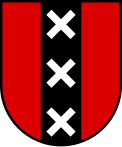Gules


In heraldry, gules (/ˈɡjuːlz/) is the tincture with the colour red, and belongs to the class of dark tinctures called "colours". In engraving, it is sometimes depicted as a region of vertical lines or else marked with gu. as an abbreviation.
In Polish heraldry, gules is the most common tincture of the field. Through the sixteenth century, nearly half of all noble coats of arms in Poland had a field gules with one or more argent charges on them.
The original coat of arms of the d'Albret family was plain gules.
Sometimes, the different tinctures are said to be connected with special meanings or virtues, and represent certain elements and precious stones. Even if this is an idea mostly disregarded by serious heraldists throughout the centuries,[1] it may be of anecdotal interest to see what they are, since people often ask for this information. Many sources give different meanings, but the gules tincture is often said to represent the following:
Etymology
The term "gules" derives from the Old French word goules, literally meaning "throats" (related to the English gullet; modern French gueules), but also used to refer to a fur neckpiece, usually made of red fur.[2]
For many decades, heraldic authors have believed that the term may have arisen from the Persian word گل (gol, "rose") (coming to Europe via Muslim Spain or brought back by returning Crusaders), but according to Brault[3] there is no evidence to support this derivation.
See also
References
- ^ Woodcock, Thomas; Robinson, John Martin (1988). The Oxford Guide to Heraldry. Oxford: Oxford University Press. p. 53. ISBN 0-19-211658-4.
- ^ Harper, Douglas. "gules". Online Etymology Dictionary.
- ^ Brault, Gerard J. (1997). Early Blazon: Heraldic Terminology in the Twelfth and Thirteenth Centuries, (2nd ed.). Woodbridge, UK: The Boydell Press. ISBN 0-85115-711-4.
